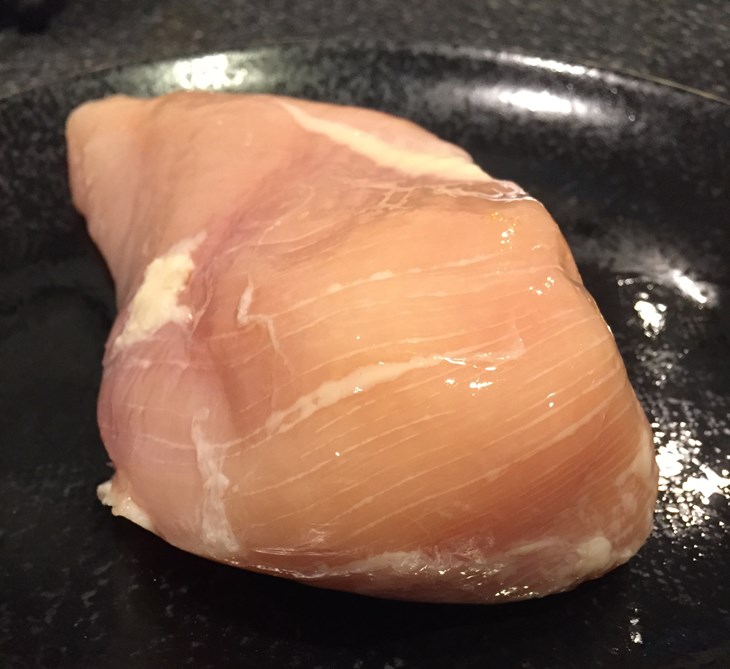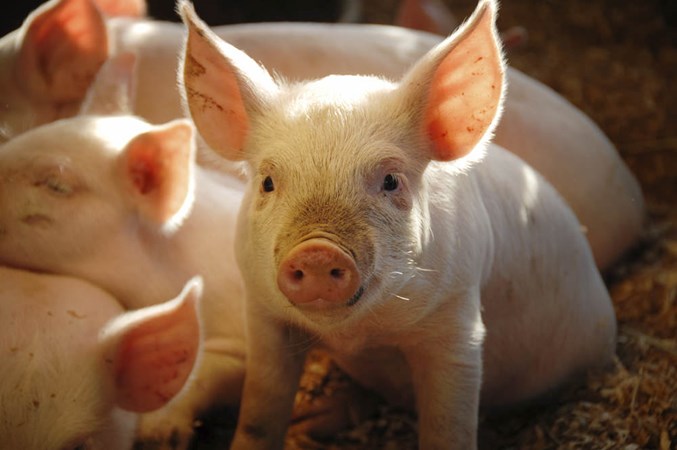Scientific research has uncovered the harsh realities of the modern chicken and how our treatment of the most farmed animals in America has impacted the meat we find in the grocery store (spoiler alert: the truth isn't pretty).
Since this story originally broke in 2017, everyone from BuzzFeed to Good Housekeeping, VICE, Cosmo and Bloomberg has helped spread the word about these hard-to-digest findings. We’ve been receiving important questions from animal advocates and conscious consumers like you, who are concerned about what this growing trend means for your health and the welfare of chickens.
Let's take a minute to answer some FAQs.
Aren’t those stripes just natural marbling?

No. While a lot of chicken meat contains a negligible amount of fat on the outside, white stripes (as seen in the example to the right) are indicative of a muscular disorder, which causes damaged muscle tissue to be replaced by fat and collagen. These fat and collagen deposits not only mean more fat, less protein, and degraded meat for the consumer but they also mean significantly more pain and suffering for the animal.
What causes white striping to occur?
Contrary to popular belief, the massive size of the modern chicken is not the result of added hormones. But rather, the muscle disorders that cause white striping—as well as another, less visible condition called “woody breast”—are linked to a chicken’s genetics. Decades of selective breeding on factory farms have resulted in birds that grow too big, too fast. As a result, their legs often cannot support their unnaturally large breasts. Plus, their heart, lungs, and other organs are often unable to keep up with the body's demand for oxygen and nutrients.
A typical chicken would spend most of its life on the move—a factory-farmed chicken spends most of its life sitting on the floor. Add to that dirty, overcrowded, and unsafe factory farm conditions, and you get defects like white striping and woody breast that severely impact the life of the chicken and the quality of food consumed by humans.
What does this mean for my health?
The science is pretty straightforward on this score: white striping means more fat—we’re talking up to 224 percent more fat—and less protein, enough to call chicken’s reputation as the leaner choice into question. And if you’re thinking that this problem probably won’t affect you, think again: one study found that a whopping 96 percent of the chicken samples tested were affected by white striping. Food for thought for the next time you consider opting for a chicken Caesar salad!
What does this mean for the chickens?
It means more suffering. The muscle disorders that cause white striping and woody breast are similar to muscular dystrophy in humans, meaning that affected chickens are in pain for most of their lives. Spotting white stripes in a raw chicken breast means you can be sure that the bird’s life was not a happy or healthy one.
What does this mean for the quality of the meat?
White striping and woody breast degrade the quality of chicken breast, not only in nutritional value but in texture and appearance. Meats affected by these disorders are often tough and chewy—so much so, that it’s starting to impact chicken companies’ bottom lines. Rather than sell it in its raw form, big poultry producers now use this degraded meat in their processed products, masking its abnormalities by breading it, frying it, or grinding it up for things like frozen nuggets. Yuck.
Can I avoid this problem by only buying organic, antibiotic-free chicken?
Sadly, no. Since diseases like white striping are genetic, organic chicken is not a hard and fast solution. In the United States, organic chickens are often the same breeds as conventional chickens, and the USDA Organic label has little meaning in terms of animal welfare. Antibiotic-free chicken only indicates the animals are not fed antibiotics and is not an indicator of better genetics or living conditions. Without also improving genetics and living conditions, removing antibiotics from the system can have devastating results. Farmers even worry that diseased birds could end up on America’s dinner plates
White striped chicken is safe to eat. Is this true?
While these muscle disorders are not considered food safety issues, they’re far from perfectly fine: they mean food that is less nutritious and less pleasant to eat—not to mention a lifetime of pain and suffering for the chicken. You may have seen that the National Chicken Council (NCC) responded to our video by saying that chicken with white striping is perfectly fine and safe for consumers. We believe in better for families and chickens everywhere.
What should I buy instead?
Luckily, the market is starting to shift, and more and more companies are committing to slower-growing breeds; however, it will take several years for them to fully transition their entire supply chains. In the meantime, consider decreasing the amount of meat, eggs, and dairy on your plate.
If you buy chicken, be sure to look for labels that clearly indicate the use of slower-growing or “heritage” breeds. Specifically, the Animal Welfare Approved certification label requires slower-growing breeds. To learn more about what to buy, download our free Compassionate Food Guide!

